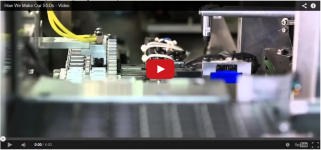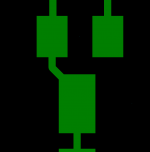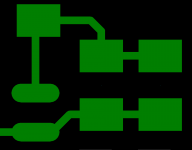I looked over the local supply of DDR disks, and yes, you guys were right, the prices have dropped rather significantly, certainly enough to warrant a detailed research of the current market for best prices. The 120 GB models is all over the place, and I noted one source offering them with up to 2 TB, however at a significant price, obviously aimed at professionals.
Last edited:
For SSDs and anything computer related really, there is a large community of tweakers so I tend to ignore marketing altogether and look for user and 3rd-party benchmarks. That's how I arrived at the Samsung. What I like the most though is that they made their own chip, whereas most other SSD manufacturers are all using a well-known chip and so all generally have certain flaws. Of course things are changing rapidly, I haven't looked at the latest SSD news.
This should be trivially easy to verify - simply exactly duplicate the PCB for a high performance audio circuit, the only variation being the substrate material; do 2 of the reference material; build. Then run a variety of music material through the boards, and sample the output at the highest resolution, and run fine tooth combs through what you get, doing diff's, etc. The 2 built of the reference material will at least indicate the variation between nominally identical assemblies.
All that's required is for someone to go through the exercise - which of course means that it will be decades before it's done, 😀 ... but, eventually ...
I am aware that there are no differences, not only have I been privy to such tests, but if you bother to look around the internet there is a wealth of information covering PCB materials and all the associated issues etc.
There is no difference for low frequency signals (sub GHz) for normal signals (rf is a different ball park), there are many more things that will have a bigger effect such as component tolerances etc etc. No difference, and this is on more critical analogue/digital than audio, all information based on signal integrity measurements and observations.
Why chase demons that don't exist!
Your probably right about the really minor effect of the PCB material. I may endeavor to measure it to put the issue into history. PCB material has changed a lot in 30 years even if the basic numbers have not. There are additives for fire retardant etc. that will have changed.
The reason I heard to avoid right angles in a layout was to prevent chemicals being trapped in the sharp corners. More 30 year old knowledge.
I keep trying to get current but current technology moves too fast.
The requirements of RoHS forced PCB materials to change due to the increased temperatures required, FR4 today is nothing like it was 30 years ago when I started doing board layout. The ever increasing speed of digital has also been a factor with much finer weaves than the traditional 1080, we often specify specific weave for some high speed designs.
mailto:mbelcher@datalink-electronics.co.uk]
The chemicals don't get trapped in sharp corners any more, again etching process has had to move on. The right angle corner acid trap is a minor problem compared to some of the complex shapes created by SMD devices and routing. The attached pictures are from a document I have done regarding complex shapes on SMD PCBs and possible problems with etching when etch factors are applied to the design, these pictures are before I have added etch compensation. One of the main points of the document was to illustrate to engineers living in the past, that coming out of the corners of SMD pads give cleaner shapes with less sharp corners and complex island that have to be etched away.
I do not use 90 deg corners on signal because they take up more space and don't look very good. But I have done a high speed design where we did one with all 90 degree corners and one mitres, there was no difference in electrical performance, and etching quality was the same on both designs.
Attachments
Here is just one page with a list of some of the possibilities: Printed Circuit Board Laminate Material Specifications by Manufacturer.
Anyone care to rank them, in "quality" for audio ... ?
FR4.....
What is the percentage of world production of PCBs that use high performance laminates? (clue its lower than you imagine)
Anyone any experience of using an SSD with Adobe Lightroom, as it does not change the image I would imagine I can store my images on an SSD as they are only being read, the changes are written to a data base, that I could keep on a standard HD...
Both my scratch and temporary folders in Photoshop point to SSDs, so I guess that is similar.
I save (as) frequently to a networked hard drive.
Large step-back/forward are almost instantneous.
I save (as) frequently to a networked hard drive.
Large step-back/forward are almost instantneous.
Cheers Cliff I'll get one and give it a go...30+ Meg raw files can take some time to play with.
Steely Dan always seems to have too much treble. It sounds pretty real when I reduce the treble somehow. Anyone know why?
Demian,
Thanks for the update on the ssd drives and the idea of a ram disk. I'm not sure how easy that is to do with the current W7 operating system and so much of my hardware and software only runs in windows. I've tried virtual machines and they are always slower than running native. My brother only runs Linux and would know how to set that up but alas it wouldn't be do do design on for me.
Right now I am doing hours of design per day. I just got offered 20% equity and salary to be the industrial designer for a new star-up, so all designs will be my own creations. They offered a new computer so I may just end up with a nice machine with ssd and an i7 thought I would love a Zeon processor and a real nice GPU video card. Thanks for the advice.
Anyone know a supplier of spst push button switches like you see in one of those very small bicycle computers or a headlight for a helmet. I need a very thin switch that is very small footprint and only sees a couple of volts, 3 max.
Thanks for the update on the ssd drives and the idea of a ram disk. I'm not sure how easy that is to do with the current W7 operating system and so much of my hardware and software only runs in windows. I've tried virtual machines and they are always slower than running native. My brother only runs Linux and would know how to set that up but alas it wouldn't be do do design on for me.
Right now I am doing hours of design per day. I just got offered 20% equity and salary to be the industrial designer for a new star-up, so all designs will be my own creations. They offered a new computer so I may just end up with a nice machine with ssd and an i7 thought I would love a Zeon processor and a real nice GPU video card. Thanks for the advice.
Anyone know a supplier of spst push button switches like you see in one of those very small bicycle computers or a headlight for a helmet. I need a very thin switch that is very small footprint and only sees a couple of volts, 3 max.
Keantoken --- yes. The EQ is set high in the treble when the music is played very loud.....the ear will reduce the treble --compress -- at high spl levels. You hear this affect a lot in live PA systems. It is EQ'ed during high spl playing/playback where is sounds flat. At lower spl it will sound too bright.
THx-RNMarsh
THx-RNMarsh
Keantokken,
Almost all of the Steely Dan albums are strictly studio albums and I don't know to many other bands that had the quality sound that they had. The final mix as in most stuff coming out of studios these days are listened to on some really crappy smaller speakers after they are mixed down on the main monitors and this is when that extra high end boost usually comes in. If they listened on some of the earlier NS10'a or little Auratone speakers this could explain that high end, those were real typical studio speakers back when I paid attention and the top end was terrible on the NS10 and non existent on the Auratones.
On a whole I haven't heard anybody complaining about Steely Dan recordings for that high end but listen to an old Yes album and that always was a sonic mess of high frequency sound. I played DJ one night in the Whiskey-A-go-go when Yes was playing in the club, early 70's and I still remember that sound, I never could listen to that music without cutting the high end!
Almost all of the Steely Dan albums are strictly studio albums and I don't know to many other bands that had the quality sound that they had. The final mix as in most stuff coming out of studios these days are listened to on some really crappy smaller speakers after they are mixed down on the main monitors and this is when that extra high end boost usually comes in. If they listened on some of the earlier NS10'a or little Auratone speakers this could explain that high end, those were real typical studio speakers back when I paid attention and the top end was terrible on the NS10 and non existent on the Auratones.
On a whole I haven't heard anybody complaining about Steely Dan recordings for that high end but listen to an old Yes album and that always was a sonic mess of high frequency sound. I played DJ one night in the Whiskey-A-go-go when Yes was playing in the club, early 70's and I still remember that sound, I never could listen to that music without cutting the high end!
I don't think I would ever play music that loud. Usually when I play music loud I wish the treble was less, not boosted! D:
EDIT: just saw your comment kindhornman.
EDIT: just saw your comment kindhornman.
Last edited:
I like Steely Dan as well, and it has always been bright in my experience.
I'm with you on that. "Steely" sounding. 😀 Very bright and brittle sound.
Demian, you are probably right that the circuit board material of today has improved, but I think I will stick with the best (by physical definition) materials for my best designs, just like Nelson, Wayne, and I am sure, Charles Hansen.
Of course, we are all in serious competition with each other, so small things matter. Heck, if I could, it would make my circuits 3 dimensional with air isolation.
Of course, we are all in serious competition with each other, so small things matter. Heck, if I could, it would make my circuits 3 dimensional with air isolation.
Last edited:
Heck, if I could, it would make my circuits 3 dimensional with air isolation.
Imagine the pick-and-place machine!
- Status
- Not open for further replies.
- Home
- Member Areas
- The Lounge
- John Curl's Blowtorch preamplifier part II


